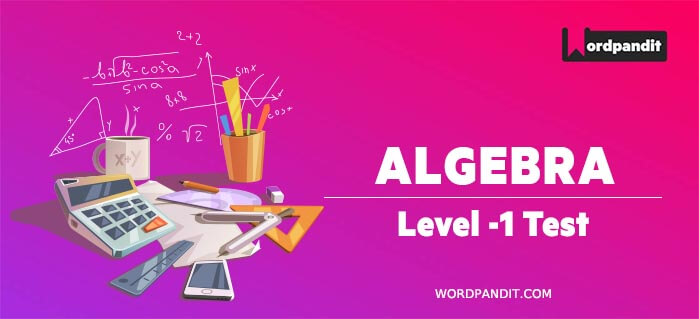- This is an assessment test.
- To draw maximum benefit, study the concepts for the topic concerned.
- Kindly take the tests in this series with a pre-defined schedule.
Algebra Level 1 Test 5
Congratulations - you have completed Algebra Level 1 Test 5.You scored %%SCORE%% out of %%TOTAL%%.You correct answer percentage: %%PERCENTAGE%% .Your performance has been rated as %%RATING%%
Your answers are highlighted below.
Question 1 |
Honey was twice as old as Vani 10 yr ago. How old is Vani today, if Honey will be 40 yr old 10 yr hence?
25 yr | |
20 yr | |
15 yr | |
35 yr |
Question 1 Explanation:
Given that Honey will be 40 yr old 10 yr
Therefore Present age of Honey = 30 yr
Honey's age 10 yr ago = 20 yr
Therefore Vani's age 10 yr ago = 10 yr
Hence Present age of Vani = 20 yr
Therefore Present age of Honey = 30 yr
Honey's age 10 yr ago = 20 yr
Therefore Vani's age 10 yr ago = 10 yr
Hence Present age of Vani = 20 yr
Question 2 |
The age of the father 5 yr ago was 5 times the age of his son. At present the father's age is 3 times that of his son. What is the present age of the father?
33 yr | |
30 yr | |
45 yr | |
None of these |
Question 2 Explanation:
Let the present age of father be = p yr
Therefore the present age of son = p/3 yr
p – 5 = 5 x (p/3 – 5)
by solving this we get p= 30 yrs
Therefore the present age of son = p/3 yr
p – 5 = 5 x (p/3 – 5)
by solving this we get p= 30 yrs
Question 3 |
A lamp post has half of its length in mud, 1/3 of its length in water and 31/3 m above the water. Find the total length of the post.
20 m | |
15 m | |
25 m | |
30 m |
Question 3 Explanation:
Let the total length of lamp post be = p m.
p =p/2 + p/3 + 10/3
p/6 = 10/3
p = 20m
p =p/2 + p/3 + 10/3
p/6 = 10/3
p = 20m
Question 4 |
There were 35 students in a hostel. If the number of students increases by 7, the expenses of the mess increase by 42 per day while the average expenditure per head diminishes by Re. 1. Find the original expenditure of the mess.
Rs. 480 | |
Rs. 520 | |
Rs. 420 | |
Rs. 460 |
Question 4 Explanation:
Let daily average expenditure per student = Rs. p.
Then, total daily expenditure = Rs. 35p
New total daily expenditure = Rs. (35p + 42)
New average expenditure = (p - 1)
Now given that
(35p + 42)/42 = p – 1
By solving this
p = Rs. 12
therefore the original expenditure = 35 x 12 = Rs. 420
Then, total daily expenditure = Rs. 35p
New total daily expenditure = Rs. (35p + 42)
New average expenditure = (p - 1)
Now given that
(35p + 42)/42 = p – 1
By solving this
p = Rs. 12
therefore the original expenditure = 35 x 12 = Rs. 420
Question 5 |
Suppose, that a maximum of 25 g of salt dissolves in 100 g of water. Any more salt, if added, remains un dissolved and a sediment falls at the bottom. Now, water is evaporated from 1 kg of a 4% solution at the rate of 28% g/h, After how long will it start sedimenting?
35 h (approx) | |
29 h (approx) | |
31 h (approx) | |
23 h (approx) |
Question 5 Explanation:
At the time of sedimentation, ratio of salt to water is 1 : 4.
Now, given that the 1000 g solution has 40 g salt and 960 g water.
Now sedimentation starts when the ratio of salt to water is 1: 4 ie, 40: 160.
The quantity of 800 g of water has to be evaporated.
Therefore the time for which evaporation takes place will be = 800/28 = 29h (approx.)
Now, given that the 1000 g solution has 40 g salt and 960 g water.
Now sedimentation starts when the ratio of salt to water is 1: 4 ie, 40: 160.
The quantity of 800 g of water has to be evaporated.
Therefore the time for which evaporation takes place will be = 800/28 = 29h (approx.)
Once you are finished, click the button below. Any items you have not completed will be marked incorrect.
There are 5 questions to complete.
List |











